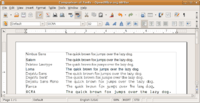The quick brown fox jumps over the lazy dog
"The quick brown fox jumps over the lazy dog" is an English-language pangram—a phrase that contains all of the letters of the alphabet. It is commonly used for touch-typing practice. It is also used to test typewriters and computer keyboards, show fonts, and other applications involving all of the letters in the English alphabet. Owing to its brevity and coherence, it has become widely known.
History
The earliest known appearance of the phrase is from The Michigan School Moderator, a journal that provided many teachers with education-related news and suggestions for lessons.[1] In an article titled "Interesting Notes" in the March 14, 1885 issue, the phrase is given as a suggestion for writing practice: "The following sentence makes a good copy for practice, as it contains every letter of the alphabet: 'A quick brown fox jumps over the lazy dog.'"[2] Note that the phrase in this case begins with the word "A" rather than "The". Several other early sources also use this variation.
As the use of typewriters grew in the late 19th century, the phrase began appearing in typing and stenography lesson books as a practice sentence. Early examples of publications which used the phrase include Illustrative Shorthand by Linda Bronson (1888),[3] How to Become Expert in Typewriting: A Complete Instructor Designed Especially for the Remington Typewriter (1890),[4] and Typewriting Instructor and Stenographer's Hand-book (1892). By the turn of the 20th century, the phrase had become widely known. In the January 10, 1903, issue of Pitman's Phonetic Journal, it is referred to as "the well known memorized typing line embracing all the letters of the alphabet".[5] Robert Baden-Powell's book Scouting for Boys (1908) uses the phrase as a practice sentence for signaling.[6]
The first message sent on the Moscow–Washington hotline was the test phrase "THE QUICK BROWN FOX JUMPED OVER THE LAZY DOG'S BACK 1234567890".[7] Later, during testing, the Russian translators sent a message asking their American counterparts "What does it mean when your people say 'The quick brown fox jumped over the lazy dog?'"[8]
During the 20th century, technicians tested typewriters and teleprinters with repeated lines of "THE QUICK BROWN FOX..." sentence.[9]
Computer usage
In the age of computers, this pangram is commonly used to display font samples and for testing computer keyboards. In cryptography, it is commonly used as a test vector for hash and encryption algorithms to verify their implementation, as well as to ensure alphabetic character set compatibility. Microsoft Word has a command to auto-type the sentence, in versions up to Word 2003, using the command =rand(), and in Microsoft Office Word 2007 and later using the command =rand.old().[10]


Cultural references
Numerous passing references to the phrase have occurred in movies, television, books, video games, advertising, websites, and graphic arts.
The lipogrammatic novel Ella Minnow Pea by Mark Dunn is built entirely around the "Quick Brown Fox" pangram and its inventor. It depicts a fictional country off the South Carolina coast that idealizes the pangram, chronicling the effects on literature and social structure as various letters are banned from daily use by government dictum.[11]
See also
- ETAOIN SHRDLU
- Filler text
- Lorem ipsum
References
- ↑ "Growing Up in Michigan, 1880-1895: One-Room School Lessons - Lesson Plan". Teachers' Stuff from the Michigan Historical Museum. State of Michigan. Retrieved December 12, 2009.
- ↑ "Interesting Notes". The Michigan School Moderator (Grand Rapids, Michigan) 5 (26): 514. March 14, 1885.
- ↑ Bronson, Linda Pennington (1888). Illustrative Shorthand. San Francisco.
- ↑ Barnes, Lovisa Ellen (1890). How to Become Expert in Typewriting.
- ↑ "The Fox Typewriter". Pitman's Phonetic Journal. January 10, 1903.
- ↑ Baden-Powell, Robert (1908). Scouting for Boys. London: Pearson. ISBN 0-665-98794-3.
- ↑ "Washington Moscow Hotline". Cryptomuseum.com. Retrieved 2013-09-21.
- ↑ Rusk, Dean (1991). As I Saw It: A Secretary of State’s Memoirs. London: I.B. Tauris & Co. Ltd. p. 225.
- ↑ "Foxing (second paragraph from the end)". Wvegter.hivemind.net. Retrieved 2013-09-21.
- ↑ "kb212251 Microsoft support". Support.microsoft.com. 2011-09-18. Retrieved 2013-09-21.
- ↑ Ella Minnow Pea: A Novel in Letters, by Mark Dunn, Anchor, 2001, ISBN 0385722435
| ||||||||||||||||||||||||||||||